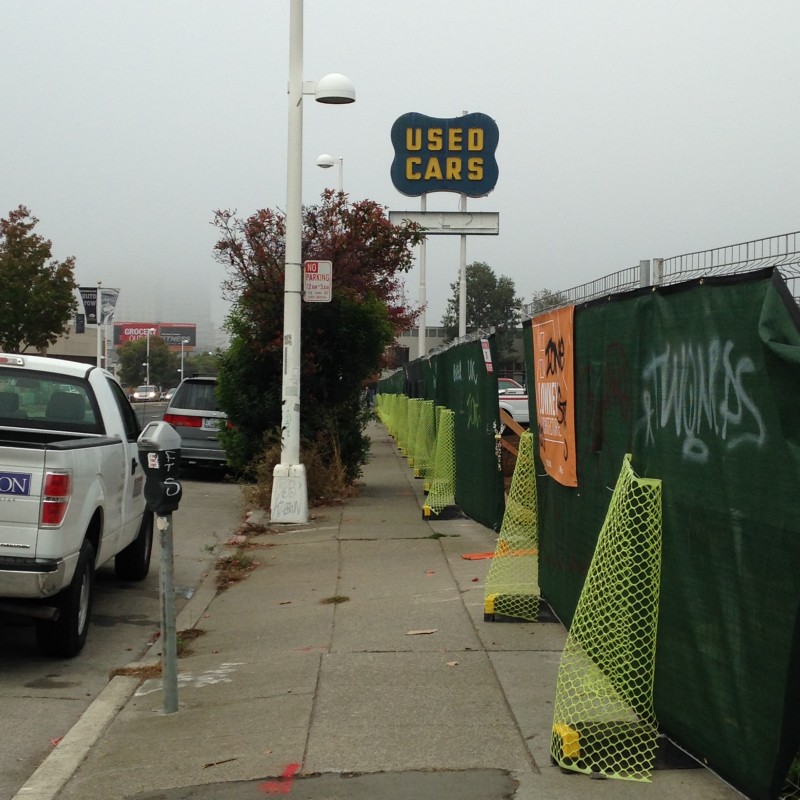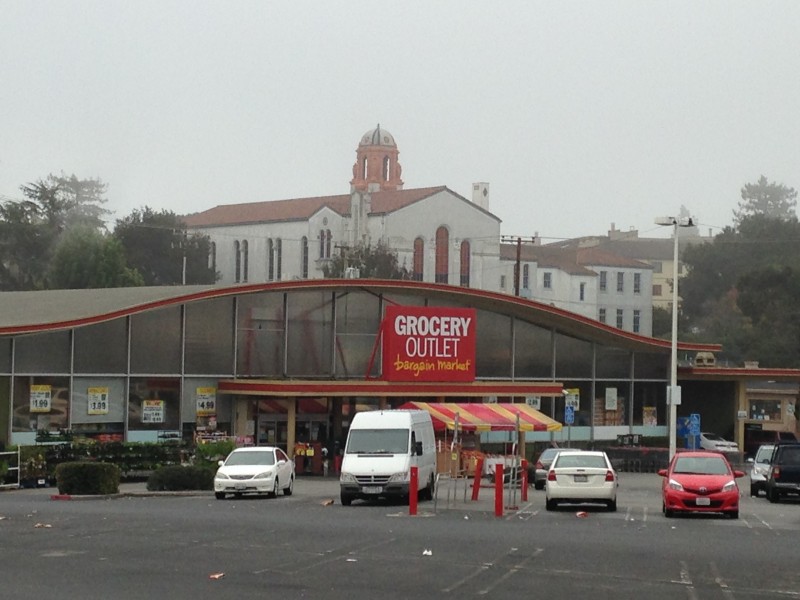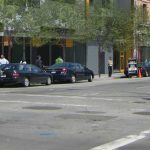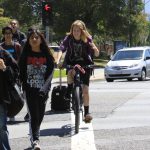Living in the Map
A reflection on the Broadway-Valdez District Specific Plan by Gloria Bruce
Maps can tell us a lot about a place’s “bones” and potential – how does a place connect to other neighborhoods? What land is really available to realize a community vision? In the case of the Broadway Valdez District, a deceptively sleepy neighborhood is revealed on a map to be ready for a burst of development. To Oakland’s city council and staff, the wide central boulevard, big underutilized parking lots, and proximity to downtown seemed like the perfect setting for big, destination retail stores.
But the map doesn’t tell the whole story, unless you really live in it. I live just outside of the top left corner of this map, and my older son’s day care is just outside the bottom right corner. I walk, bike, drive or ride the bus right through this map on a daily basis. Along with other members of the Better Broadway Coalition – a group led by EBHO and Greenbelt Alliance and supported by GCC for 6 years – I knew from lived experience that this was a quirky, unfinished but potentially vibrant residential and commercial neighborhood that needed more than big-box stores. Those of us who lived in this map pushed for and won a more balanced vision including mixed-income housing, walkability, and stores serving current residents (see the specific wins here on the GCC blog).
True, we have much further to go to win binding requirements for affordable housing, anti-displacement, and quality jobs. But we learned a few key lessons that EBHO at least will carry into other campaigns:
- Combine the professional and the personal;
- Get over some of our ideas about urban design;
- Know that changing the conversation is a victory
Combine the professional and the personal
It’s not profound or new to say that truly knowing a place helps you shape a better vision for it. But this campaign was such an excellent example of combining professional expertise with personal experience that it merits some discussion.
For example, you wouldn’t know from the map that three unromantic towers on Valdez Street are home to over 600 seniors living in non-profit affordable housing. Even though they represent the densest concentration of residents in the District, these seniors were at first somewhat overlooked by the city staff. Through partnering with EBHO’s Resident & Community Organizing Program, the residents of Valdez Plaza and Westlake Christian Terrace were heard – asking for and getting more community meetings, services in their languages, and deeper knowledge of land use and the planning process.The senior residents demanded better sidewalks and bus shelters, more affordable homes like the ones they live in, and neighborhood-serving stores. Crucially, their arguments were bolstered by analysis from by Greenbelt Alliance, Pyatok Architects, Walk Oakland Bike Oakland and others in the coalition who brought evidence that 1,800 homes were possible, that union jobs were needed, and that innovative parking management could work. The combination of the expert residents and the expert architects and planners gave us strong credibility with city decision-makers.
I’m excited that the Broadway corridor will soon have two businesses that will directly serve these seniors: a grocery store specializing in fresh produce on what is now a parking lot, and a CVS in a historic former car dealership.

A former used car lot on its way to becoming a new grocery store.
This leads me to my next point – sometimes we need to get over our ideas about urban design.
A good “urbanist” wouldn’t normally be pleased about the arrival of a chain drug store. Of course, we want to encourage independent small businesses like those that have enlivened Broadway Valdez in recent years (including a “cat cafe”). However, because I live in this map and regularly walk my sons past desolate, trash-strewn parking lots, I know that this corridor needs an infusion of economic activity. If that catalyst happens to be a chain pharmacy – one that the seniors at Valdez Plaza and Westlake have clamored for – that’s OK by me, especially if I can pick up some diapers on the way to CatTown.
By the same token, some planners might shake their heads at the eyesore that is the parking lot of the Grocery Outlet at 30th & Broadway. On the map, this is a key catalytic site that should probably be redeveloped with a 5-story mixed-use building. But the current unbeautiful store serves everyone from hipsters scoping out deals on organic Greek yogurt to big families stocking up on shampoo and spices; and it has a unionized workforce to boot. A consensus has emerged that spans young and old, affluent and struggling, labor activist and foodie – whatever happens to the Broadway corridor, our “Gross Out” isn’t going anywhere. True, some architects might want to “pull up” the store closer to Broadway so that the parking lot is behind the building. But they might not realize that the current entrance is directly across the street from the back gate of Valdez Plaza – so a gain in aesthetics and “street activation” would be a loss of immediate access for folks with limited mobility.

The Grocery Outlet (and behind it, the Oakland Peace Center) – two best kept secrets of the Broadway Valdez corridor.
These types of tough and tiny choices are behind every decision that advocates push for and city planners make, and there are no perfect solutions. The point is, though, that sometimes our best academic ideas about urban design need to give way to community reality.
Finally, changing the conversation is sometimes the victory.
I have to put our wins on the Broadway Valdez plan in some context. While stakeholders had some real disagreements, there was also a good deal of consensus about welcoming development and creating a diverse, walkable neighborhood that combined old and new. I suspect that’s because Broadway Valdez has not suffered the systematic and devastating displacement that has characterized West Oakland and Chinatown – planning processes in those neighborhoods were much more fraught. And with all our progress in creating great goals in the plan, we still couldn’t win strong enough requirements for affordable homes or ensure that lower-income people living near the Central Business District won’t be displaced for higher-end development.
However, we got everyone talking about these concerns. We won language demanding that Oakland do a nexus study to explore a development impact fee. We insisted that the city development a program to mitigate displacement. Both of these points were then incorporated in the West Oakland and Lake Merritt Area specific plans. The language isn’t binding but it’s been picked up by the Planning Commission and the City Council, who now openly talk about displacement and the possibility of private development helping to pay for public goods. Note that a mixed-use development slated for a key site will include 15% affordable housing – not because the city requires it, but because the developers know that the community is watching and everyone is talking about the need for inclusive community.
We have a long way to go, but just changing this conversation about development in Oakland is a huge win. I’m excited to live in this map as the dialogue about Broadway Valdez continues and our vision is realized both on paper and on the ground.





